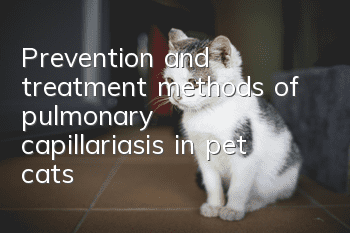Prevention and treatment methods of pulmonary capillariasis in pet cats

Pulmonary capillariasis is a parasitic disease in cats, caused by pulmonary capillaries. It mainly lives in the trachea and bronchi of cats.
1. Characteristics of the disease
Host animals include foxes, cats, and dogs, and other animals are not susceptible to infection. Food and drinking water are contaminated with infectious eggs and infected through the mouth of dogs and cats. No intermediate host is required.
2. Main symptoms
When the number of infections is small, there are basically no clinical symptoms, and sick cats occasionally have a slight cough. Severe infections in cats often cause rhinitis, chronic bronchitis, tracheitis, cough, and difficulty breathing. The sick cats gradually lose weight, become anemic, and have rough coats.
3. Treatment methods
Levamisole 5 mm/kg body weight, taken orally, once a day, for 5 days, discontinued for 9 days, and then repeated for two courses; 5 mg/kg body weight can also be injected subcutaneously, once a day, for 2 days 15 days later, double the dose and repeat once. Benzimidazole 6 mg/kg body weight, orally, 2 times a day, for 5 days.
4. Preventive measures
1. Treat sick cats and worm-carrying cats promptly; feed cooked food that is not contaminated by feces. Take good care of the cat's feces, clean the cat's coat frequently, and keep the cat's house hygienic.
2. Cats should be inspected once a quarter and dewormed in time. Sites with serious pollution should be kept dry and fully exposed to the sun to kill insect eggs.
Only by conducting regular inspections and timely deworming and isolating suspected pathogens can the disease rate be minimized.
- Is neutering a female cat dangerous? Things to pay attention to and care methods for neutering female cats!
- What foods should cats not touch? You need to know the dietary taboos for cats!
- Can cats be walked? Choose the right equipment and your cat can still be walked!
- What is calicivirus and how to treat cats with calicivirus
- British shorthair requirements for indoor temperature
- How to train a Norwegian Forest Cat to roll on the ground
- Tips for getting your cat used to being cuddled
- Aphthous sores on cat’s mouth
- Can cats eat grapes and raisins?
- What should I do if my cat is afraid of water and doesn’t like bathing?



